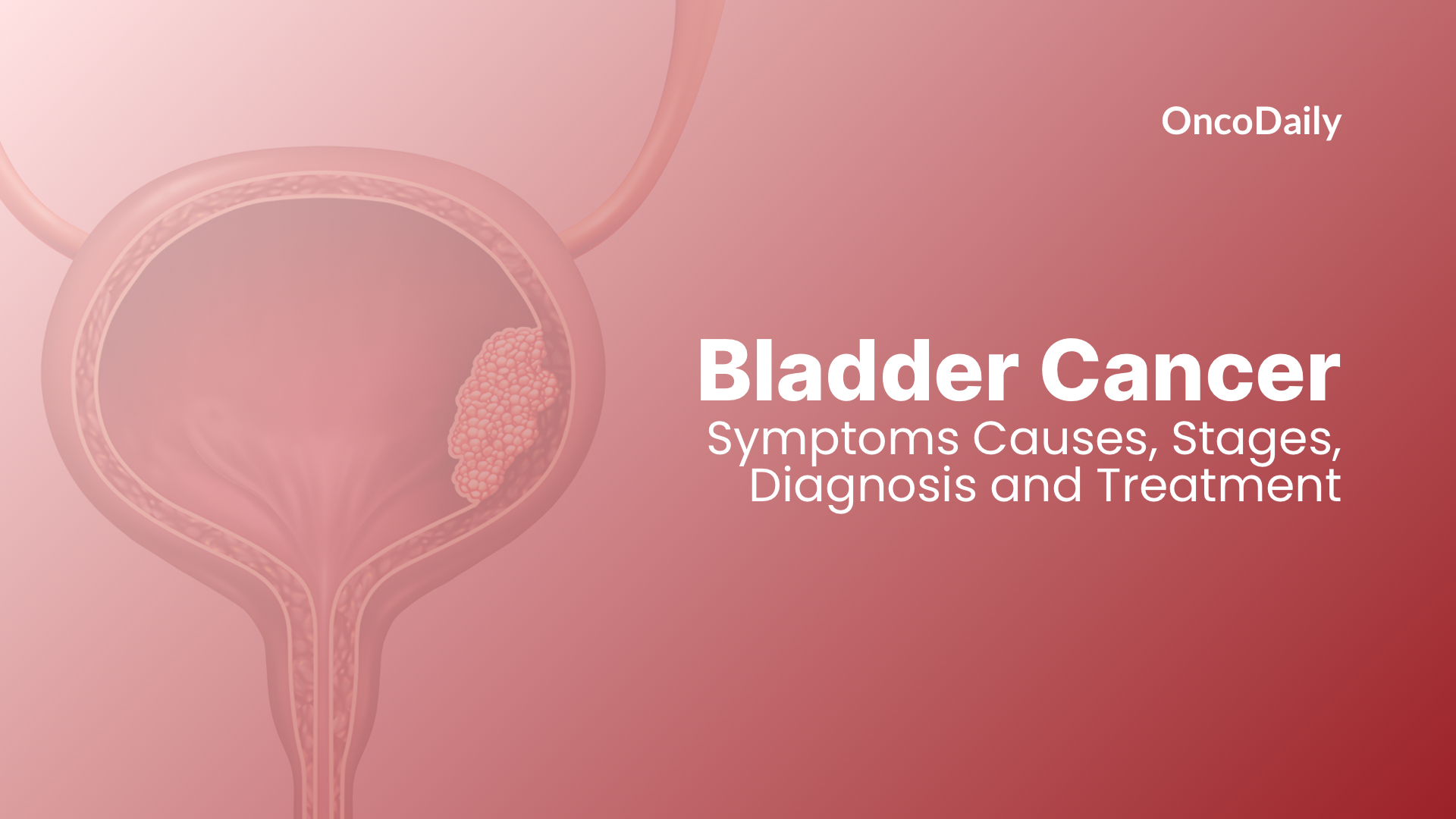Bladder cancer is one of the most common malignancies worldwide, affecting the urinary system and often diagnosed at later stages due to its subtle early symptoms. The disease develops in the urothelial cells lining the bladder and is strongly associated with environmental and genetic factors.
According to the American Cancer Society, bladder cancer accounts for approximately 83,000 new cases annually in the United States alone, leading to about 17,000 deaths each year. The five-year survival rate varies significantly depending on the stage at diagnosis, ranging from 77% for localized cases to 6% for metastatic disease. It is more common in men, with a threefold higher risk compared to women, and its incidence increases with age.
This article will provide an in-depth exploration of bladder cancer, including its symptoms, causes, risk factors, staging, diagnostic methods, treatment options, and post-treatment care.
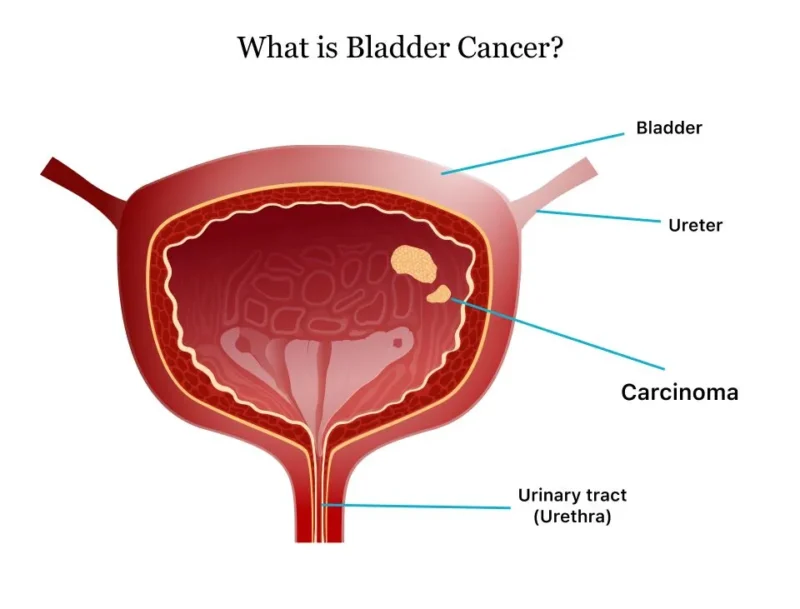
What Are the Symptoms of Bladder Cancer?
What are the Causes and Risk Factors for Bladder Cancer?
Bladder cancer arises from genetic mutations that cause uncontrolled cell growth. While the exact mechanisms are not fully understood, several risk factors significantly increase the likelihood of developing the disease.
- Smoking – The leading cause, responsible for nearly 50% of all bladder cancer cases. Carcinogens in tobacco are absorbed into the bloodstream and excreted in urine, where they damage bladder cells over time. ( American Cancer Society)
- Chemical Exposure – Industrial chemicals such as aromatic amines, used in dye, rubber, and textile industries, are strongly linked to bladder cancer.
- Chronic Bladder Inflammation – Long-term irritation from catheter use, recurrent infections, or bladder stones can promote cancerous changes.
- Radiation Therapy – Prior pelvic radiation increases the risk of bladder cancer.
- Certain Chemotherapy Drugs – Cyclophosphamide, used to treat some cancers, has been associated with a higher incidence of bladder malignancies.
- Age – Bladder cancer is rare in young people but significantly increases after age 55.
- Gender – Men are three times more likely to develop bladder cancer than women.
- Family History – Individuals with a close relative who had bladder cancer have a higher risk.
- Previous Bladder Cancer – Recurrence is common, even after successful treatment.
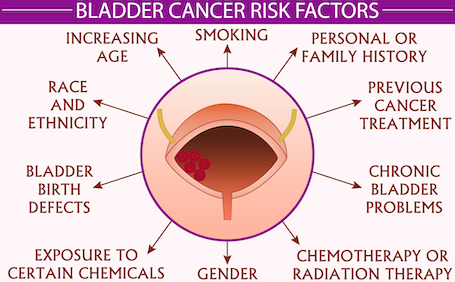
What Are the Types of Bladder Cancer?
Bladder cancer is classified based on the type of cells involved:
- Urothelial Carcinoma (Transitional Cell Carcinoma, TCC)
- Squamous Cell Carcinoma of the Bladder
- Adenocarcinoma of the Bladder
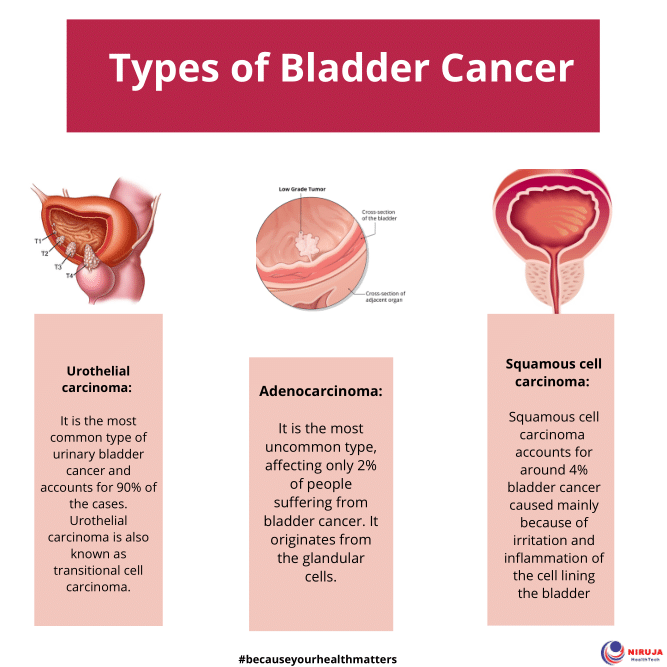
How Is Bladder Cancer Diagnosed?
Accurate diagnosis and staging are crucial in the management of bladder cancer, as they guide treatment planning and influence prognosis. Several diagnostic methods are employed to detect and evaluate bladder cancer:
- Cystoscopy and Biopsy: Cystoscopy is a primary diagnostic tool where a urologist inserts a cystoscope—a thin, flexible tube equipped with a light and camera—through the urethra to visually inspect the bladder’s interior for abnormalities. If suspicious areas are identified, a biopsy can be performed during the procedure to obtain tissue samples for histopathological examination. This approach allows for direct visualization and tissue diagnosis, essential for confirming malignancy.
A significant contribution is the development of “CystoNet-T”, a transformer-augmented deep learning algorithm designed to improve bladder tumor detection in white-light cystoscopy. In the study “Tumor Detection under Cystoscopy with Transformer-Augmented Deep Learning Algorithm,” Xiao Jia et al. This integration enhances multi-scale feature representation with global context, leading to more accurate tumor detection. Evaluated on a test set comprising 101 images from 13 patients, CystoNet-T achieved an F1 score of 96.4 and an Average Precision (AP) of 91.4. These results represent improvements of 7.3 points in F1 and 3.8 points in AP over benchmarks like Faster R-CNN and YOLO. The study highlights the model’s effectiveness in precise tumor localization while minimizing false positives. - Urinalysis and Urine Cytology: Urinalysis involves analyzing a urine sample to detect blood, proteins, and other substances that may indicate urinary tract issues. Urine cytology specifically examines urine under a microscope to identify cancerous cells shed from the bladder lining. While non-invasive, urine cytology may not detect all bladder cancers, particularly low-grade tumors.
- Computed Tomography (CT) Urogram: This imaging test involves injecting a contrast dye into a vein, followed by CT scans of the urinary tract. It provides detailed images of the kidneys, ureters, and bladder, helping to identify tumors, blockages, or other abnormalities.
- Magnetic Resonance Imaging (MRI): MRI uses magnetic fields and radio waves to produce detailed images of the bladder and surrounding tissues. It is particularly useful in evaluating the depth of tumor invasion and involvement of adjacent structures.
What Are the Treatment Options for Bladder Cancer?
Bladder cancer treatment depends on several factors, including the stage of the disease, the type of cancer, the patient’s overall health, and their personal preferences. The approach can range from minimally invasive procedures to radical surgery, combined with chemotherapy, radiation, or immunotherapy to prevent recurrence or manage advanced disease.
Surgical Options for Bladder Cancer
One of the most common treatment methods, especially for early-stage bladder cancer, is transurethral resection of the bladder tumor (TURBT). This procedure is performed through a cystoscope inserted into the bladder via the urethra, allowing surgeons to remove visible tumors without the need for an external incision. TURBT is often the first step, not just for treatment but also for diagnosis, as tissue samples are taken to determine cancer grade and stage. However, bladder cancer has a notoriously high recurrence rate—around 50-70% of cases will develop new tumors within five years, which is why TURBT is often followed by intravesical therapy to kill any remaining cancer cells.
One of the most effective intravesical treatments is Bacillus Calmette-Guérin (BCG) therapy, which uses a weakened strain of Mycobacterium bovis to stimulate the immune system to attack cancer cells in the bladder lining. This therapy is particularly effective for non-muscle-invasive bladder cancer (NMIBC), reducing recurrence and progression rates. BCG is administered directly into the bladder via a catheter, and while it is highly effective, it can cause flu-like symptoms and bladder irritation. Some patients may experience urinary urgency, pain, or blood in their urine during treatment, but these side effects typically resolve over time.
For more advanced cases, where cancer has invaded the muscle layer of the bladder (muscle-invasive bladder cancer, MIBC), more aggressive treatments are required. One of the primary options is radical cystectomy, a major surgery where the entire bladder is removed. In men, this often includes removing the prostate and seminal vesicles, while in women, the uterus, ovaries, and part of the vaginal wall may also be removed. Radical cystectomy requires reconstructing the urinary system, which can be done in different ways. Some patients receive a urostomy, where urine is diverted through a stoma into an external bag. Others may be candidates for a neobladder, a new bladder created from a section of the intestine, allowing for more natural urination. While a neobladder offers greater quality of life, it comes with challenges, such as the need to retrain the body to urinate, potential incontinence, and difficulty emptying the bladder completely.
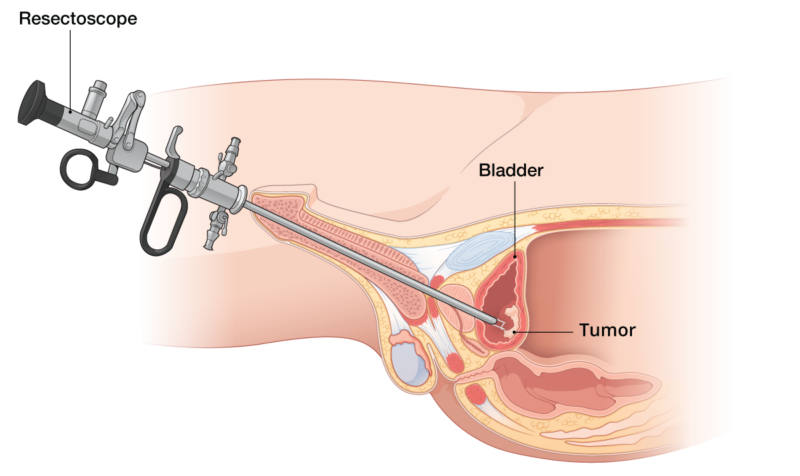
Chemotherapy for Bladder Cancer
Chemotherapy plays a pivotal role in managing muscle-invasive bladder cancer (MIBC), particularly as neoadjuvant (pre-surgical) therapy. Administering chemotherapy before surgery aims to shrink tumors, thereby facilitating more effective surgical removal and addressing potential micrometastases.
Clinical evidence underscores the benefits of neoadjuvant chemotherapy in MIBC. A meta-analysis of 11 clinical trials demonstrated a 5% absolute improvement in 5-year overall survival for patients receiving neoadjuvant chemotherapy followed by surgery, compared to surgery alone. This translates to an increase in survival from approximately 50% to 55%. The first author of this study is C.L. Vale, and the findings are published in the European Urology journal.
- Gemcitabine + Cisplatin (GC) – One of the most widely used regimens.
- MVAC (Methotrexate, Vinblastine, Adriamycin, and Cisplatin) – A stronger combination that may work faster but can have more side effects.
- Carboplatin-based chemotherapy – Used for patients who cannot tolerate cisplatin.

Read More About Immunotherapy for Bladder Cancer on OncoDaily
While chemotherapy can enhance survival outcomes, it is associated with several side effects due to its impact on both cancerous and healthy rapidly dividing cells. Common side effects include:
- Nausea and Vomiting: Chemotherapy agents can irritate the gastrointestinal tract, leading to these symptoms.
- Fatigue: A prevalent side effect, often resulting from anemia or the body’s energy being diverted to repair tissues.
- Hair Loss: Due to the effect of chemotherapy on hair follicle cells.
- Infection Risk: Lowered white blood cell counts can increase susceptibility to infections.
- Loss of Appetite: Changes in taste and nausea can lead to decreased food intake.
- Diarrhea: Chemotherapy can affect the cells lining the intestines.
- Sore Mouth and Throat: Mucositis can occur, leading to discomfort and difficulty swallowing.
- Peripheral Neuropathy: Some agents cause nerve damage, leading to tingling or numbness in extremities.
These side effects are detailed by the American Cancer Society, with the first author being Rebecca L. Siegel.
Radiation Therapy for Bladder Cancer
Bladder cancer can be aggressive, and in some cases, doctors may recommend radiation therapy as part of treatment. This approach uses high-energy beams (like X-rays) to destroy cancer cells, either as an alternative to surgery or to relieve symptoms in advanced cancer. For many patients, radiation offers a chance to keep their bladder while still effectively fighting the disease.
Radiation therapy targets cancer cells and stops them from growing. Unlike chemotherapy, which affects the whole body, radiation is focused on a specific area, reducing damage to healthy tissues.There are two main ways it is used

Read more About Radiotherapy for Bladder Cancer on OncoDaily
- External Beam Radiation Therapy (EBRT): The most common method, where a machine outside the body directs radiation at the bladder.
- Internal Radiation Therapy (Brachytherapy): Less common, this involves placing radioactive material inside the bladder to deliver radiation directly to the tumor.
Some patients with muscle-invasive bladder cancer can avoid bladder removal by combining radiation with chemotherapy (known as trimodal therapy).This allows patients to keep their bladder while still treating the cancer effectively. After Surgery (Adjuvant Therapy), Used to kill remaining cancer cells after surgery and lower the risk of recurrence. For Advanced Cancer (Palliative Care).If the cancer has spread and cannot be removed, radiation can shrink tumors, ease pain, and stop bleeding.
Possible Side Effects
- Bladder irritation: More frequent urination, discomfort, or blood in the urine.
- Bowel problems: Diarrhea or cramping due to radiation affecting nearby intestines.
- Fatigue: Feeling more tired than usual during and after treatment.
- Skin reactions: Redness or irritation in the treated area.
Most side effects go away after treatment, but some, like bladder or bowel changes, can last longer in rare cases.
Treatment of Metastatic Bladder Cancer
For many years, metastatic bladder cancer was one of the most difficult cancers to treat. Chemotherapy was the standard option, and while it worked for some patients, it often stopped working over time. When chemotherapy failed, there were few alternatives, and survival rates remained low.
But today, new treatments are changing that reality. Scientists have developed targeted therapies and immunotherapies that help patients live longer, even when standard treatments no longer work.
One of the most promising new treatments for bladder cancer is Enfortumab Vedotin (EV), an antibody-drug conjugate (ADC). Unlike traditional chemotherapy, which kills all fast-growing cells, EV is designed to attack cancer cells specifically.
- EV targets a protein called Nectin-4, which is found on most bladder cancer cells.
- Once attached, it delivers a powerful cancer-killing drug inside the tumor, destroying the cancer from within.
- Because it focuses on cancer cells, it causes less damage to healthy cells than traditional chemotherapy.
Studies show that EV is effective even in patients whose cancer has stopped responding to chemotherapy and immunotherapy. It can:
- Shrink tumors in a significant number of patients.
- Slow the spread of the disease, helping patients live longer.
- Improve symptoms, reducing pain and discomfort caused by the cancer.
However, not all patients respond the same way. Some bladder cancer types, like neuroendocrine variants, do not respond well to EV. Scientists are now studying how biomarkers like Nectin-4 levels might help doctors predict who will benefit most.
Recent Advancement in Bladder Cancer
Recent advancements in bladder cancer research have led to significant improvements in diagnosis, treatment, and patient outcomes. This article highlights key developments, including novel therapeutic agents, innovative diagnostic techniques, and emerging technologies.
- Enfortumab Vedotin and Pembrolizumab Combination: A pivotal study demonstrated that combining enfortumab vedotin with pembrolizumab significantly improved survival rates in patients with advanced bladder cancer. The trial reported a median overall survival of 31.5 months for the combination therapy group, compared to 16.1 months for those receiving standard chemotherapy, effectively doubling patient survival. These findings were published in The Lancet Oncology by lead author Dr. Thomas Powles.
- Nogapendekin Alfa Inbakicept (Anktiva): Approved by the FDA in April 2024, nogapendekin alfa inbakicept is an interleukin-15 receptor agonist used in combination with Bacillus Calmette-Guérin (BCG) for treating BCG-unresponsive non-muscle invasive bladder cancer. Clinical trials indicated a complete response rate of approximately 51%, with a median duration of 9.7 months. Lead researcher Dr. Patrick Soon-Shiong detailed these results in The New England Journal of Medicine.
- Erdafitinib (Balversa): Erdafitinib, a fibroblast growth factor receptor (FGFR) inhibitor, received FDA approval for adults with locally advanced or metastatic urothelial carcinoma harboring susceptible FGFR3 genetic alterations. Clinical trials reported an overall response rate of 32.2%, with 2.3% achieving complete responses and a median response duration of approximately 5.5 months. These findings were published in The Lancet by lead author Dr. Yohann Loriot.
- Artificial Intelligence in Cystoscopy: Researchers have developed a deep learning model that combines Convolutional Neural Networks (CNNs) with transformers to enhance the detection and segmentation of bladder tumors during cystoscopy. This AI-driven approach aims to improve diagnostic accuracy while reducing reliance on operator expertise. The study, led by Meryem Amaouche, was published in IEEE Transactions on Medical Imaging.
- Non-Invasive High-Intensity Focused Ultrasound (HIFU): A novel HIFU toroidal transducer has been utilized to non-invasively target bladder tumors. In vivo studies demonstrated successful ablation of bladder wall tissues, suggesting a potential alternative to traditional surgical methods. This research, conducted by Victor Delattre and colleagues, was detailed in The Journal of Therapeutic Ultrasound.
- Microrobots for Targeted Drug Delivery: Innovative 3D-printed microrobots, thinner than a human hair, have been developed to deliver drugs directly to bladder cancer cells. In preclinical trials, these microrobots successfully reduced tumor size in mice, offering a promising platform for precise drug delivery. The study, authored by Wei Gao, was published in Science Robotics.
- Advanced Imaging Techniques: The integration of advanced imaging modalities, such as MRI, into the diagnostic pathway has expedited treatment planning. A recent study found that utilizing MRI scans reduced the time to treatment initiation from 14 weeks to 7 weeks, allowing for quicker and more accurate therapeutic decisions. These findings were reported in The Journal of Clinical Oncology by lead author Dr. Emma Smith.
What Are the Stages of Bladder Cancer?
Bladder cancer progresses through distinct stages, starting with Non-Muscle-Invasive Bladder Cancer (NMIBC), where tumors are confined to the bladder lining and have not penetrated the muscle. This stage includes superficial cancers like Ta (growing outward) and Tis (a flat, aggressive form), as well as T1, which invades the connective tissue but not the muscle. It has a high survival rate if treated early with procedures like transurethral resection (TURBT) and intravesical therapies.
As the cancer advances to Muscle-Invasive Bladder Cancer (MIBC), it spreads into the bladder’s muscular wall (T2-T4 stages). This form is more aggressive and typically requires surgery (such as bladder removal), chemotherapy, or radiation. In Metastatic Bladder Cancer, cancer has spread to distant organs like the lungs or liver (Stage IV). Treatment focuses on systemic therapies to slow progression and manage symptoms. Early detection is crucial for improving outcomes across all stages.
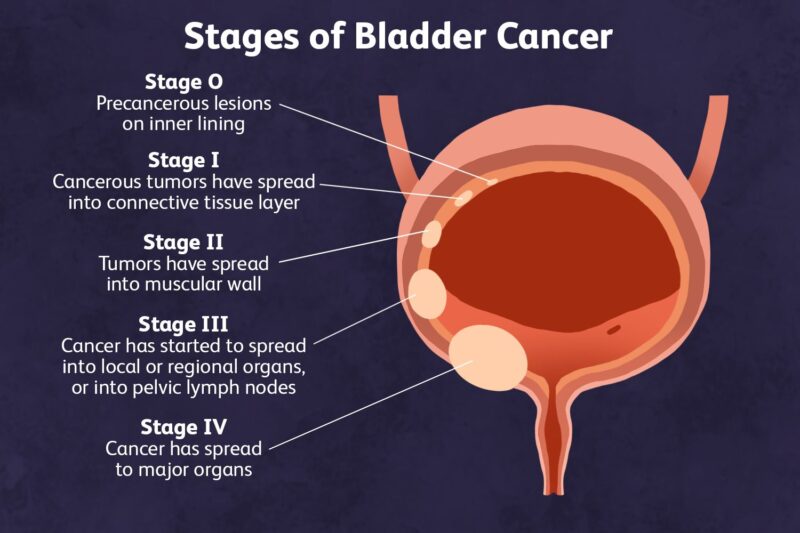
How Long Does It Take to Notice and Cure Bladder Cancer?
The timeline from symptom onset to treatment varies widely. Many patients first notice blood in the urine (hematuria), which can be intermittent and often ignored, leading to delayed diagnosis.
- Symptom Recognition: It may take weeks to months before patients seek medical help for hematuria or urinary changes.
- Diagnosis: Once a patient consults a doctor, a urinalysis, cystoscopy, and imaging tests (CT scan, MRI) are performed. Diagnosis can typically be confirmed within two weeks.
- Treatment Initiation:For NMIBC (Stages 0-I): TURBT is usually performed within a few weeks of diagnosis, followed by intravesical therapy (such as BCG) starting within a month.For MIBC (Stages II-III): Neoadjuvant chemotherapy is typically given for 2-3 months, followed by surgery (radical cystectomy) or bladder-preserving radiation.For Stage IV (Metastatic disease): Chemotherapy or immunotherapy starts as soon as possible after staging, often within a few weeks of diagnosis.
How to Live with Bladder Cancer?
A bladder cancer diagnosis is life-changing, requiring adjustments in diet, lifestyle, and emotional well-being.
- Diet and Hydration: Drinking plenty of water (2-3 liters per day) is essential, especially for those with urinary diversions. A low-irritant diet (avoiding spicy foods, alcohol, caffeine) can help reduce bladder irritation.
- Exercise and Strength Maintenance: Light exercise, such as walking or yoga, helps combat fatigue from chemotherapy or surgery. Strength training is beneficial after radical cystectomy to regain muscle lost during recovery.
- Emotional Support: Many patients experience depression and anxiety post-treatment. Support groups, therapy, and talking to other survivors help improve mental health and coping strategies.
- Urinary Adaptation: Patients who undergo radical cystectomy with an ileal conduit (urostomy) need time to adjust to living with an external urine collection bag. Others who receive a neobladder must learn how to control urination again.
Can Bladder Cancer Be Prevented?
While not all cases can be prevented, several lifestyle changes significantly reduce risk:
- Quit Smoking: Smoking is responsible for 50-65% of bladder cancer cases. Stopping smoking reduces the risk of recurrence and progression.
- Avoid Chemical Exposure: Occupational exposure to dyes, rubber, and industrial chemicals increases bladder cancer risk. Protective measures, such as wearing PPE, can help minimize exposure.
- Stay Hydrated: Drinking plenty of fluids flushes toxins from the bladder and may lower cancer risk.
- Regular Screening: High-risk individuals, such as those with a strong family history or chronic bladder inflammation, should undergo periodic cystoscopy and urine tests.
You Can Watch More on OncoDaily Youtube TV
Written by Armen Gevorgyan, MD
FAQ
What Is Bladder Cancer?
Bladder cancer occurs when abnormal cells grow uncontrollably in the bladder lining. It is one of the most common cancers, especially in older adults.
How Common Is Bladder Cancer?
Bladder cancer is the 10th most common cancer worldwide, with approximately 573,000 new cases and 213,000 deaths annually (WHO, 2024).
What Are the Symptoms of Bladder Cancer?
Common symptoms include blood in the urine (hematuria), frequent urination, pain during urination, and lower back pain.
What Causes Bladder Cancer?
Bladder cancer is primarily caused by smoking, exposure to harmful chemicals, chronic bladder infections, and genetic factors.
What Are the Stages of Bladder Cancer?
Bladder cancer is staged from 0 to IV, depending on how deeply the cancer has invaded the bladder wall and whether it has spread.
How Is Bladder Cancer Diagnosed?
Diagnosis involves urinalysis, cystoscopy, imaging tests (CT, MRI), and biopsy to confirm the presence of cancer cells.
What Are the Treatment Options for Bladder Cancer?
Treatment depends on the stage and may include surgery, chemotherapy, radiation therapy, immunotherapy (e.g., Keytruda, BCG), or targeted therapy.
Can Bladder Cancer Be Prevented?
Reducing risk involves quitting smoking, avoiding chemical exposure, drinking plenty of fluids, and maintaining a healthy diet.
Is Bladder Cancer More Common in Men or Women?
Bladder cancer is 3-4 times more common in men than women, but women often get diagnosed at a later stage.
Can Bladder Cancer Recur After Treatment?
Yes, bladder cancer has a high recurrence rate, so regular follow-ups with cystoscopy and imaging are essential for early detection.
